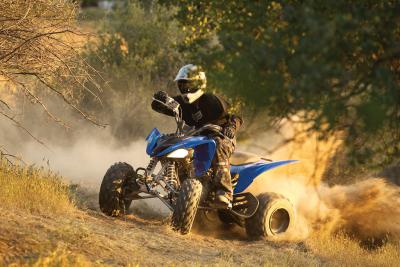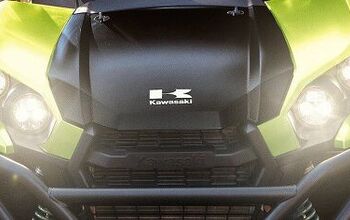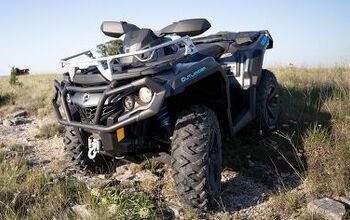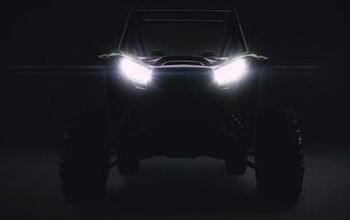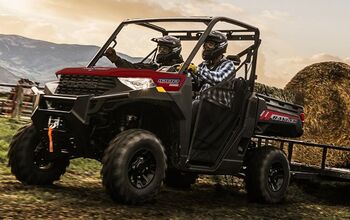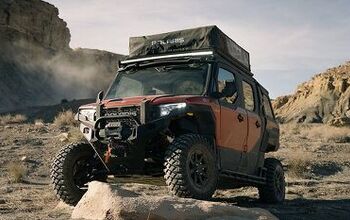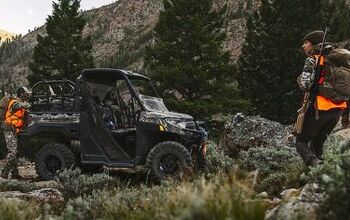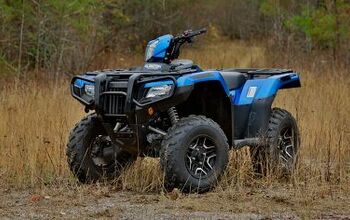2009 Yamaha Raptor 250 Review
Have you ever had a little brother that looked up to you? Who liked to follow in your footsteps since the day he was born? Think of the Yamaha Raptor 250 as the little brother who placed his foot, every stride and every step he ever made, right in yours. Now imagine that little brother had that ability to learn from the mistakes that you made. Born with many family traits like tremendous power, precise handling and intimidating looks, the 2009 Yamaha Raptor 250 had a head start from day one.
Yamaha first welcomed the Raptor 250 into this world in 2008 after the death of its closest cousin, the Yamaha Blaster. It may have been the coughing that got the best of him (EPA regulations). With quite a reputation to live up to, the first thing Yamaha looked at when designing the Raptor 250 was the engine. Because of ever increasing regulations on emissions, 2-stroke engines were out of the question, so Yamaha decided to go with an existing engine from its motorcycle family.
The Raptor 250 has borrowed a lot of features from the YFZ450 and the Raptor 700.
Yamaha’s engine of choice is from a trick/stunt motorcycle sold in Europe, the Yamaha Trixter. This engine is known for its low-end torque, light weight, quick revving, air-cooled design with the ability to start with a push of a button. This engine also features a wet sump system and a ceramic composite plated cylinder to help disperse heat and prolong engine life.
The five speed manual transmission, unlike many of its in-class competitors, gives the rider the ability to feather the clutch and excel out of the corners. Yamaha chose to exclude the reverse gear to save weight, just like the Blaster. The Raptor 250 weighs in at just 313 pounds dry, making it the lightest quad in the 250cc sport class, nearly 50 pounds lighter than the reported curb weight of its predominant competitor, the Honda TRX250EX.
With its light weight the Raptor 250 is nimble and easy to handle.
Many of the Raptor’s competitors in the Sport 250 class use a shaft driven system. Yamaha went in a different direction, choosing again to copy the Raptor’s big brothers by using a chain and sprocket drive system. This choice not only cuts down on weight, but it also gives the Raptor 250 an advantage by being able to accelerate faster than many of its competitors. The Raptor 250 inherited the same chain adjustment as the Raptor 700 and the YFZ450. But that’s not all that the Raptor 250 borrowed from the Yamaha family, it also received its rotors and master cylinders from the YFZ450, giving the Raptor 250 the ability to stop on a dime.
The preload adjustable shocks provide 7.5 inches of travel up front and 7.9 in the rear.
With its light weight and nimble nature, the Raptor 250 is easy to maintain control of, wheter you’re in the air or on the ground. It features a pair of preload adjustable shocks up front with 7.5 inches of travel and 7.9 inches of travel on the rear; making the Raptor 250 triumph over its competitors in suspension travel. Also helping soak up the terrain and deliver power to the ground, Yamaha added a set of specially designed Dunlop tires to the rolled aluminum wheels.
Yamaha kept its consumer in mind while designing this ATV. The Yamaha Raptor 250 was designed for intermediate riders who were in the transition from riding a 90cc ATV to a bigger displacement model like the Yamaha YFZ450. The Raptor 250 offers these transitional riders a perfect quad to sharpen their skills, like maintaining and learning to maneuver their machine in all conditions.
We were invited by Yamaha to come out and race a Raptor 250 and experience first hand what it’s like to aggressively ride this tyrant of a machine. The place Yamaha chose had a variety of terrain and well is known in the ATV racing world – the infamous Glen Helen Raceway. Located in the heart of southern California’s racing scene, Glen Helen Raceway offered us a full plate of varied conditions for our hungry Raptor 250. From long straights, massive berms and motocross jumps to tedious up hills that never seem to end, Glen Helen was a perfect spot to push the Raptor 250 to its limits.
Right off the starting gate the Raptor 250 dug right in. We took advantage of the manual clutch and feathered the power to shoot us quickly towards first corner and down the straight. The guys at Yamaha were correct when they said it was quick revving engine, because before we knew it we were headed towards the first up hill with the throttle pinned in fifth gear. We quickly shifted down to prevent the Raptor from bogging down the engine going up the hill, but to our surprise it just keep raging along.
This is an ideal quad for people just getting into the sport.
It didn’t take long before he came to the first set of jumps and before we knew it we were airborne. The Raptor 250 was easy to throw around in midair because of its light weight and compact design. The preload adjustable shocks up front and in the rear soaked up most of the impact of landing. It was now time for the whooped out sandy section that grew worse as the day progressed. We were in awe how well the Raptor 250 handled the ruts. A combination of its suspension and chassis design gave us the ability to ‘point and shoot’ the machine where ever we wanted it to go, with little to no bump steer. There was nothing be tried at Glen Helen Raceway that the Raptor 250 couldn’t handle. There was one climb we didn’t get a chance to try. The locals call it Mount. St. Helen. Even though we felt the Raptor 250 had enough power to climb it, no one on the staff was up for trying to do so.
The styling on the Raptor 250 makes it look fast.
If you step back and take a look at the Raptor 250, it gives off an aura of intimidation. Even though the Sport 250 class consists of so called ‘sport’ quads, most of them are not truly sport machines. Most in the class are just relabeled utility quads with stylish plastic geared towards riders just beginning to get into the sport. The Raptor 250, just like its big brother the Raptor 700, is a thrill to ride and truly is a sport quad in every aspect.
If you don’t like Team Yamaha blue, the Raptor 250 also comes in white.
Since its birth, the Raptor 250 has proven itself to be quite a bully. It’s the leader of its class with many advantages, including less weight, manual five speed transmission, preload adjustable suspension and stylish looks. No wonder the Raptor 250 owns not only the playground, but is the winner of Consumer Digest Best Buy Award in the sport ATV category for 2008.
It’s the best 250 sport quad we’ve had the opportunity to ride. We can’t wait until the other manufacturers step up to the challenge and build a better one.
| 2009 Yamaha Raptor 250 Specs | |
| Engine Type: | 249cc air-/oil-cooled 4-stroke; SOHC, 2 valves |
| Bore x Stroke: | 74 x 58 mm |
| Compression Ratio: | 9.5:1 |
| Fuel Delivery: | Mikuni 29mm BSR |
| Ignition: | DC-CDI |
| Transmission: | 5-speed; wet multiplate clutch |
| Drive Train: | 2WD; sealed O-ring chain, eccentric adjustment |
| Front Suspension: | Independent double wishbone; 5-way preload-adjustable shocks, 7.5-in travel |
| Rear Suspension: | Swingarm, preload-adjustable, 7.9-in travel |
| Front Brakes: | Dual hydraulic disc |
| Rear Brake: | Hydraulic disc |
| Front Tires: | AT20 x 7-10 (Dunlop) |
| Rear Tires: | AT19 x 10-9 (Dunlop) |
| Length/Width/Height: | 64.0 x 42.1 x 40.9 in |
| Dry weight: | 313 lbs |
| Wheelbase: | 43.7 in |
| Seat Height: | 28.7 in |
| Ground Clearance: | 3.9 in |
| Fuel Capacity: | 2.4 US gal. |
| Lighting: | Dual 30W Krypton multireflector headlights & 21/5W brakelight |
| Colors: | Team Yamaha Blue/White; White/Red |
| MSRP: | $4,199 |
Related Reading:
More by ATV.com Staff




